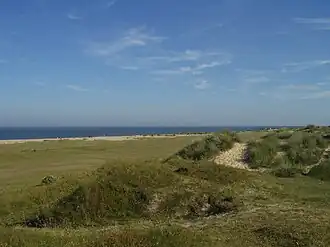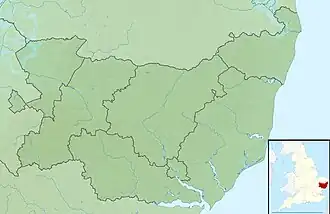Kessingland Lifeboat Station
| Kessingland Lifeboat Station | |
|---|---|
 | |
 Kessingland Beach. | |
 Kessingland, Suffolk | |
| General information | |
| Status | Closed |
| Type | RNLI Lifeboat Station |
| Address | Church Road |
| Town or city | Kessingland, Suffolk |
| Country | England |
| Coordinates | 52°24′40.4″N 1°43′39.6″E / 52.411222°N 1.727667°E |
| Opened | 1855 / RNLI 1867 |
| Closed | 1936 |
Kessingland Lifeboat Station was primarily located at the north end of Church Lane in Kessingland, a village approx 6 miles (9.7 km) south of Lowestoft, on the Suffolk coast.[1]
A lifeboat was first placed at Kessingland by the local boatmen in 1855. Operations by the Royal National Lifeboat Institution (RNLI) began in 1867.[2]
After 81 years of operation, Kessingland Lifeboat Station closed in 1936.[3]
History
In 1855, a lifeboat was acquired for Kessingland by the local boatmen. A new boat costing maybe £200 was out of reach, the boatmen having raised locally the sum of £73. A second-hand 40-foot x 11-foot lifeboat was purchased from Southwold. Assistance from the RNLI was requested, answered with a grant of £10, and a set of life-belts, costing £14.[4]
Following a visit and report by Capt. D. Robertson, RN, Assistant Inspector of Lifeboats, at a meeting of the RNLI committee of management on Thursday 6 June 1867, it was decided to establish a station at Kessingland. A new boathouse, costing £164, was constructed at Benacre, just to the south of Kessingland, near Beach Farm. With a self-righting lifeboat not suiting the requirements of the local boatmen, a 33-foot Norfolk and Suffolk-class 'Pulling and Sailing' (P&S) lifeboat, one with sails and (12) oars, was placed at the station. Funded from the generous donation of £500 from Mr John Hargreaves of Broad Oak, Accrington in Lancashire, at his request, the lifeboat was named Grace and Lally of Broadoak (ON 26).[5][6][7]
By 1869, the second-hand lifeboat acquired in 1855 by the Kessingland boatmen had become unseaworthy, and was condemned. The RNLI decided to place another lifeboat at Kessingland, and a second boathouse was constructed nearer the village, at the north end of what is now Church Street, at a cost of £266.[8]
A large 42-foot Norfolk and Suffolk-class lifeboat, built by Beeching of Great Yarmouth, and costing £270-5s, was sent to Kessingland. The new station would now be known as Kessingland No.1, with the earlier station at Benacre becoming Kessingland No.2. The new lifeboat was funded by the people of Bolton le Moors. Several of the Bolton branch organising committee attended the inauguration and naming ceremony on 17 November 1870, when the boat was named Bolton (ON 25).[8]
In 1883, Coxswain George Strowger was awarded the RNLI Silver Medal, in recognition of his long service since the establishment of the station, including service to the following vessels:[9]
- Schooner Centaur of Exeter, (26–27 October 1865), saved five of the seven crew.[10]
- Schooner Admiral Jervis of Gravesend, (10 December 1868), saved the crew of five.[11]
- Brigantine Flora (1870)
- Schooner Jessie (1874)
- Brig Sir William Pulteney (6 October 1874), rescued the crew of 15.[12]
- Brig Lady Havelock (30 November 1877), rescued the crew of eight.[13]
- Barque Cleopas of South Shields (13 January 1879), rescued the crew of 10.[14][15]
- Brig Maria of Hartlepool (14 October 1881), rescued the crew of six.[16][17]
- Brig Marnhull of Weymouth (10 February 1883), rescued five of the six crew.[18][19]
Following requests by the lifeboat crew for a larger lifeboat (than the existing No.2 station boat) for use around the sand-banks, a 38-foot lifeboat was sent to the station, establishing Kessingland No.3 station. The lifeboat was built by Beeching of Great Yarmouth, and cost £363, with boathouse work costing an additional £337. The lifeboat was sailed to its station from Great Yarmouth by its crew, arriving on 24 March 1884. The lifeboat was named Charles Bury (ON 27), the cost of the lifeboat defrayed from the legacy of the said Charles Bury of Nazeing, Essex. The lifeboat operated until 1897, and was then withdrawn. [20]
Coxswain George Strowger would receive a second RNLI Silver Medal (Second-service clasp) in 1895 for his continued service, including to the following vessels:[21]
- Steamship Empress (1890)
- Schooner Kate and Elizabeth of Portsmouth (18 May 1891), Rescued the Master, his daughter, and four crew.[22]
- Brigantine Alberta of Whitstable (23 February 1894), rescued the crew of eight.[23]
Kessingland Lifeboat Station continued to operate a No. 3 lifeboat until 1897, and the No. 2 lifeboat until 1918. Finally, likely due to reduced numbers of sailing vessels falling victim to the weather, and with motor-powered lifeboats at the flanking stations of Lowestoft and Aldeburgh, Kessingland Lifeboat Station closed in 1936.[3]
A building still stands on the Kessingland site, although it is unclear if anything remains of the original station. The station site at Benacre has long been lost to the sea. The lifeboat on station at the time of closure, 34-foot Norfolk and Suffolk (P&S) lifeboat Hugh Taylor (ON 629), was sold from service the same year, and was last reported as a yacht in Dordrecht in 1987.[24]
Notable rescues
On the 11 December 1919, in gale-force conditions, the Smack A. J. W. of Rye, East Sussex ran aground on Newcombe Sands off Lowestoft. The Kessingland lifeboat St Paul (ON 406) was launched, nearly being driven back ashore but for the quick raising of the sails. The cries of the survivors help locate the sunken smack, and four men were seen clinging to the two visible masts. Setting anchor and veering down, one man was recovered, but the three remaining men were in a more difficult position. At great risk to the lifeboat and crew, the Coxswain veered the lifeboat over the rails of the boat, between the two masts, and the remaining three crew were rescued.[25]
For this service, Coxswain George Knights and Second Coxswain Edward Smith were each awarded the RNLI Silver Medal. Each of the 14 remaining lifeboat crew were awarded the RNLI Bronze Medal.[26]
Station honours
The following are awards made at Kessingland.[27]
- George Strowger, Coxswain – 1883
- George Strowger, Coxswain – 1895 (Second-Service clasp)
- George Henry Knights, Coxswain – 1920
- Edward John Smith, Second Coxswain – 1920
- Christopher Crispin Smith, Bowman – 1920
- Ernest William Bagot, crew member – 1920
- George Blowers, crew member – 1920
- Sidney James Brown, crew member – 1920
- Richard Catchpole, crew member – 1920
- William Hart, crew member – 1920
- John B. Jeffery, crew member – 1920
- Louis Henry Kemp, crew member – 1920
- J. C. Mudditt, crew member – 1920
- Herbert Thacker, crew member – 1920
- Alfred Utting, crew member – 1920
- Arthur Utting, crew member – 1920
- Alfred Wigg, crew member – 1920
- Wilfred Wigg, crew member – 1920
Roll of Honour
In memory of those lost whilst serving Kessingland lifeboat.
- Lost when the lifeboat capsized during launch to a vessel from Great Yarmouth, 15 July 1875
- Thomas Tripp
Kessingland / Kessingland No. 1
| ON[a] | Name | Built | On Station[28] | Class | Comments |
|---|---|---|---|---|---|
| – | Unnamed | 1870 | 1855−1869 | 40-foot x 11-foot (P&S) | [Note 1] Kessingland Boatmen lifeboat |
| 25 | Bolton | 1870 | 1870−1893 | 42-foot 3in Norfolk and Suffolk (P&S) | [Note 2] |
| 352 | Bolton | 1893 | 1893−1902 1902–1918 |
43-foot Norfolk and Suffolk (P&S) | [Note 3] On loan to Aldeburgh in 1902. |
| 406 | St Paul | 1897 | 1918−1931 | 38-foot Norfolk and Suffolk (P&S) | [Note 4] |
| 629 | Hugh Taylor | 1912 | 1931−1936 | 34-foot Norfolk and Suffolk (P&S) | [Note 5] |
- Station Closed, 1936
Kessingland / Kessingland No. 2 (Benacre)
52°24′40.4″N 1°43′39.6″E / 52.411222°N 1.727667°E
| ON[a] | Name | Built | On Station[28] | Class | Comments |
|---|---|---|---|---|---|
| 26 | Grace and Lally of Broadoak; St Michaels, Paddington |
1867 | 1867−1879 1879–1897 |
32-foot Norfolk and Suffolk (P&S) | [Note 6] |
| 406 | St Paul | 1897 | 1897−1918 | 38-foot Norfolk and Suffolk (P&S) | [Note 7] |
- Station Closed, 1918
Kessingland No. 3
| ON[a] | Name | Built | On Station[28] | Class | Comments |
|---|---|---|---|---|---|
| 27 | Charles Bury | 1884 | 1884−1897 | 38-foot 6in Norfolk and Suffolk (P&S) | [Note 8] |
- Station Closed, 1897
See also
Notes
- ^ 40-foot x 11-foot (P&S) lifeboat costing £73.
- ^ 42-foot 3in x 12-foot (14-oared) Norfolk & Suffolk-class (P&S) lifeboat, built by Beeching of Great Yarmouth, costing £270-5s.
- ^ 43-foot Norfolk & Suffolk-class (P&S) lifeboat.
- ^ 38-foot Norfolk & Suffolk-class (P&S) lifeboat
- ^ 34-foot Norfolk & Suffolk-class (P&S) lifeboat
- ^ 32-foot x 10-foot (12-oared) Norfolk & Suffolk-class (P&S) lifeboat, built by Beeching of Great Yarmouth, costing £155-10s.
- ^ 38-foot Norfolk & Suffolk-class (P&S) lifeboat
- ^ 38-foot 6in x 12-foot (12-oared) Norfolk & Suffolk-class (P&S) lifeboat, costing £362-16s.
References
- ^ "Suffolk Sheet XIX.NE". Maps. National Library of Scotland. Retrieved 12 July 2025.
- ^ Leonard, Richie; Denton, Tony (2025). Lifeboat Enthusiasts Handbook 2025. Lifeboat Enthusiasts Society. p. 117.
- ^ a b Leonard & Denton 2025, p. 117.
- ^ "Additional Stations and New Life-Boats". The Lifeboat. II (19): 119. 1 January 1856. Retrieved 12 July 2025.
- ^ "Summary of the Meetings of the Committee". The Lifeboat. VI (66): 496. October 1867. Retrieved 12 July 2025.
- ^ "Additional Stations and New Life-Boats". The Lifeboat. VI (69): 721. 1 July 1868. Retrieved 12 July 2025.
- ^ "Suffolk Sheet XIX.SE". Maps. National Library of Scotland. Retrieved 12 July 2025.
- ^ a b "Additional Stations and New Life-Boats". The Lifeboat. VIII (82): 183. 1 November 1871. Retrieved 12 July 2025.
- ^ Cox, Barry (1998). Lifeboat Gallantry. Spink & Son Ltd. p. 175. ISBN 0907605893.
- ^ "Summary of the Meetings of the Committee". The Lifeboat. VI (61): 204. 2 July 1866. Retrieved 12 July 2025.
- ^ "Summary of the Meetings of the Committee". The Lifeboat. VII (73): 244. 1 July 1869. Retrieved 12 July 2025.
- ^ "Shipwreck of the Suffolk Coast". Star. Vol. 61, no. 48. Saint Peter Port. 10 October 1874.
- ^ "Lady Havelock". The Lifeboat. X (107): 215. 1 February 1878. Retrieved 12 July 2025.
- ^ "Shipping Disasters and Loss of Life". Bristol Mercury. No. 9567. Bristol. 14 January 1879.
- ^ "Cleopas". The Lifeboat. X (113): 581. 1 August 1879. Retrieved 12 July 2025.
- ^ "The Gale". The Times. No. 30326. London. 15 October 1881. col B-E, p. 5.
- ^ "Maria". The Lifeboat. XI (123): 455. 1 February 1882. Retrieved 12 July 2025.
- ^ "Marnhull". The Lifeboat. XII (130): 202. 1 November 1883. Retrieved 12 July 2025.
- ^ "Disasters At Sea". The Times. No. 30742. London. 13 February 1883. col E, p. 10.
- ^ "Additional Stations and New Life-Boats". The Lifeboat. XII (134): 440. 1 November 1884. Retrieved 12 July 2025.
- ^ Cox 1998, p. 204.
- ^ "Kate and Elizabeth". The Lifeboat. XV (163): 7. 1 February 1892. Retrieved 12 July 2025.
- ^ "Alberta". The Lifeboat. XV (174): 808. 1 November 1894. Retrieved 12 July 2025.
- ^ Leonard & Denton 2025, pp. 40–41.
- ^ "The Sailing Smack A.J. W., of Rye". The Lifeboat. XXIV (268): 18. February 1920. Retrieved 12 July 2025.
- ^ Cox 1998, p. 248.
- ^ Cox 1998, pp. 175, 204, 248.
- ^ a b c Leonard & Denton 2025, pp. 4–41.